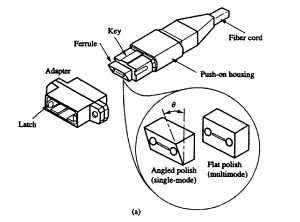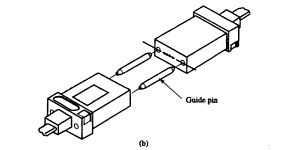Given the many different types of fibre-optic data links in a modern enterprise data centre, the design of an optical cable infrastructure that will accommodate both current and future needs has become increasingly complicated. For example, IBM Site and Connectivity Services have developed structured cabling systems to support multi-gigigabit cable plants. In this section, we briefly describe several recent innovations in fibre-optic cable and connector technology for the IBM structured cabling solution (FS can provide the fibre cable assemblies), known as Fibre Transport Services (FTS) or Fibre Quick Connect (FQC).
A central concept of FTS is the use of multifibre trunks, rather than collections of two fibre optic patch cords, to interconnect the various elements of a large data centre. FTS provides up to 144 fibres in a common trunk, which greatly simplifies cable management and reduces installation time. Cable congestion has become a significant problem in large data centres, with up to 256 ESCON channels on a large director or host processor. With the introduction of smaller, aircooled CMOS-based processors and the extended distance provided by optical fibre attachments, it is increasingly common for data processing equimpment to be rearranged and moved to different locations, sometimes on a daily basis. It can be time consuming to reroute 256 individual jumper cables without making any connection errors or accidentally damaging the cables. To relieve this problem, in 2007 FTS and S/390 introduced the Fibre Quick Connect system for multifibre trunks.

The trunks are terminated with a special 12-fibre optical connector known as a Multifibre Termination Push-on (MTP) connectors. Each MTP contains 12 fibres or 6 dulpex channels in a connector smaller than most duplex connections in use today (barely 0.5 inches wide). In this way, a 72-fibre trunk cable can be terminated with six MTP connectors (buy the MTP/MPO cables with MTP to MPO fibre connector); relocating a 256-channel ECSON director now requires only re-plugging 43 connections. Trunk cables terminated with multiple MTP connectors are available in four versions, either 12 fibre/6 channels, 36 fibre/18 channels, 72/36 channels, or 144 fibre/72 channels. Optical alignment is facilitated by a pair of metal guide pins in the ferrule of a male MTP connector, which mate with corresponding holes in the female MTP connector. Under the covers of a director or enterprise host processor, the MTP connectors attach to a couple bracket (similar to a miniature patch panel); from there, a cable harness fans out each MTP into 6 duplex connectors that mate with the fibre optic transceivers. Since the qualifications of the cable harness, under the covers patch panel, and trunk cable strain relief for FTS are all done in collaboration with the mainframe server development organization, the FTS solution functions as an intergral part of the applications.

At the other end of the FTS trunk, individual fibre channels are fanned out at a patch panel or main distribution facility (MDF), where duplex fibre connectors are used to re-configure individual channels to different destinations. These fanouts are available for different fibre-optic connector types, although ESCON and Subcriber Connection (SC) duplex are most common for multimode and SC duplex for single mode. Fanning out the duplex fibre connections at an MDF also offers the advantage of being able to arrange the MDF connections in consecutive order of the channel identifibres on the host machine, greatly simplifying link reconfigurations. As the size of the serves has been reduced and the number of channels has increased , the size of the MDF has become a limiting factor in many installations. In order to keep the MDF from occupying more floor space than the processors, a dense optical connector technology was required for the Fibre Quick Connect system. To meet this need, IBM Global Services has adopted a new small form factor fibre-optic connector as the preferred interconnect for multimode patch panels, the SC-DC. Structured cabling solutions similar to this are available from other companies as well; they may include overhead or underfloor cable trays and raceways, as well as cabinets or rack-mounted enclosures (standard units are compatible with either 19-or 23-inch wide equimpment racks, with heights between 1 and 7 U tall).
About FS:
FS is a largest manufacturer & supplier of fibre optic network solutions in China. The company has been providing fibre optic cables, patch cables, transceivers, media converters and testers & tools for nearly ten years. Now you can custom your own optical networking devices and assemblies directly on the website.
